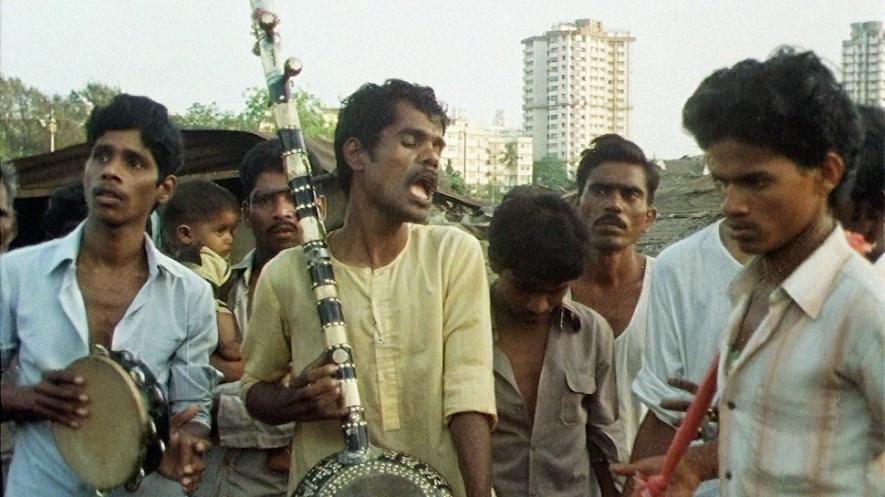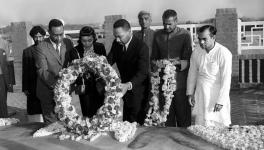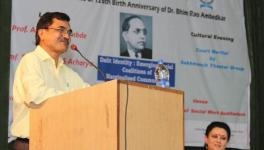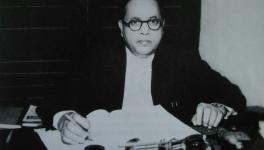Vilas Ghogre: Tribute to a People's Poet

Image Courtesy: Harvard Film Archive
Art, or more precisely revolutionary art, has historically been the instrument of resisting against the lived experiences of oppression, subordination and alienation. Revolutionary artforms are represented in different forms and methods depending on the conditions and masses it was meant for.
Shahiri, particularly Ambedkarite “Shahiri”, is the tradition of poor masses whose collective identity is marked by the experiences of historical injustices and discrimination based on caste hierarchy. The history of anti-caste Shahiri goes back to centuries in the Maharashtra region. With the changing socio-political landscapes in the region, it has gone through notable transformations. Therefore, it is important to remember the great poet of downtrodden people, who's name had been left behind somewhere in the pages of history.
Vilas Ghogre, a revolutionary balladeer has enriched the heritage of Ambedkarite Shahiri. Despite his remarkable contributions and dedication to the Ambedkarite cause, he has remained a largely untouched and unknown figure.
Documentary filmmaker Anand Patwardhan paid homage to Vilas through his documentary “Jai Bhim Comrade”. This documentary displays the intersection of caste, class and power inherited in the post-colonial Indian state. The film also reveals how caste oppression has survived in its brutal form even today in a liberal democracy. This writer is one of the many people who was introduced to the revolutionary heritage of Vilas through this documentary. Therefore, this article attempts to dive into the socio-political aspects of his life.
Early life and association with class-based issues
Vilas was born to a poor Dalit family in Pune. At a tender age, he had begun to see the cruelties of the social circumstances he was born in. Along with the declining material conditions, he was introduced to the world with the stigma of caste that would make his life full of contradictions.
Early in life, Vilas was introduced to the progressive “bhajans” of Bhakti poet Kabir. His father, Bhikaji Ghogre, used to sing hymns of Kabir. For people born in a caste-ridden society, the identity of the lower born determines their material existence. This is apparent in the life of Vilas, who would later struggle for two meals per day.
After his father passed away due to excessive alcoholism, Vilas went to Mumbai in the hope for better opportunities. Until his arrival in a mega city like Mumbai, he was inherited with the legacy of “Shahiri Jalsa” by his father.
Poet and author, Yogesh Maitreyi writes:
“During the early 1960s, Maharashtra was going through social — but more evidently — political upheavals. Shahiri jalsas played an important role in the formation of the state of Maharashtra. Vilas was witness to one such jalsa of the shahir Jangamswami. He realised then that shahiri would become his life’s work and purpose. However, this journey of music and activism wasn’t going to be easy. In 1965, he was forced to move to Mumbai, in search of a job”.
The devotion of Vilas to the “Shahiri” tradition was due to the empirical reality of his life. Only with an “Iktara”, a musical instrument, he would agitate to serve a larger humanitarian cause. Influenced by Kabir and his father, his early encounters with the tragedies of human life, material existence and struggle for the bare minimum culminated into an inclination toward the tradition of Ambedkarite folk singing.
Vilas worked at factories, as a vegetable vendor, simultaneously performed. The jobs did not get him the bare minimum needed for survival in a big city. Therefore, he started singing in public gatherings and tried to be part of a larger public conscience on the oppressive nature of the Brahmanical system.
Already a life full of contradictions, Vilas was witness to another tragedy of life when Kamal, his wife, died during her pregnancy. His life shattered into pieces before his eyes. The demise of his wife had a never- ending impact on him. Yogesh Maitreyi points out that, “This pain, however, did not stop him from pursuing his life’s calling: shahiri. Soon after this, in 1971, he wrote his first song. His early songs were about his vision and his understanding of labour through the lens of politics. He portrayed the dreadful life of the workers that he observed up close, since he was a worker himself in Mumbai. He also spoke of his life as a Dalit — a life that he had inherited”.
Vilas, who had served as daily wage labourer, knew the pain and suffering of labourers working in inhumane conditions. As noted above, two decisive impediments of his life were as a worker and a Dalit. He was aware of the brutalities of the both Brahmanical and capitalist social structure.
In his popular work, “Katha Suno re Logo”, sang about the Dalit slums. He termed the Indian State a “Jhootha Raj” (False State). A “Raj” of savarna (upper caste) elites, who adjusted themselves to the post-colonial Indian State with their power and privileges. The Indian state is a false state, meant to serve the interests of the ruling class under the garb of social welfarism and compensatory remittances, he sang.
It was during these years that a radical organisation, such as Dalit Panther, was formed to battle Brahmanical oppression. The revelations of the Elayaperumal Committee on the rising atrocities against Dalits and Buddhists paved the way for the establishment of the organisation. The Dalit-Bahujan youth began entering the political scene with a feeling of anger and retaliation against Brahmanical oppression. Perhaps, the consciousness of Vilas was developed by these happenings, too.
Further, in his “Katha Suno re logo”, Vilas addresses the “feudal” nature of the Indian state. The Indian State, after decades of political independence, has remained with the remnants of a feudal social structure with concentration of wealth in the hands of few sections. Vilas was associated with a Marxist cultural group, Avahan Natya Manch, for a long time, until he was accused of disciplinary action by the group. His Marxist allies objected to his singing for public gatherings of specific politicians. However, Yogesh Maitreyi writes that Vilas remained associated with the same cultural group till his death.
Ramabai Nagar Killings and Vilas Ghogre’s last message.
On July 11, 1997, the residents of Ramabai Ambedkar Nagar witnessed one of the cruelest mass killings of Dalits in India, who were protesting against the desecration of Ambedkar's statue by the upper castes. Babasaheb Ambedkar’s statue was garlanded with shoes and sandals.
Days after the incident, Vilas decided to visit the site of the incident. He was deeply saddened and troubled by the mass killings of Dalits and could not bear the pain of their suffering. What he witnessed at that moment had left nothing of him inside him. Perhaps, it was not the same Villas of the past, who depicted the pain, triumph and stories of Dalits with his poetic mastery. On July 15, 1997, Vilas reportedly died by suicide at his residence, killing himself with a blue scarf around his neck and a slogan written on his wall, “Ambedkari Ekta Zindabad”.
Vilas’s call for the unification of Ambedkarites was a political message that urged the Bahujan community to ponder about their political reality.
Conclusion
Suicides are most often outcomes of the cruelties of our society. Vilas, who survived the harshest conditions in his life, couldn't bear the pain of Ramabai Ambedkar Nagar Killings. A person who mastered the language of expressing grief in ballads and poetry was left with the undying memory of the worst form of caste brutalities against his people.
Despite the horrible happenings then, statues of Bahujan icons are still being inked black and removed in contemporary India on a regular basis. In 2016, we witnessed the death by suicide of Dalit PhD scholar Rohith Vemula in Hyderabad, who ended his life after persistent oppression by the Brahmanical institution. In his suicide note, he termed his birth as a “fatal accident”. A collective ‘fatal accident’ that unfortunately sticks with people belonging to the downtrodden sections.
Such suicides are not merely institutional murders, these are abetted by interests that seek to saffronise the public and private sphere of life with a Brahmanical social code. The “jhootha raj” we are living in, has all the means to turn things unbearable to the extent that Dalits may choose to end their lives.
Vilas Ghogre remains a shining star in the Ambedkarite Shahiri tradition. He is a never-ending force that continues to inspire people across the barriers of caste, class and gender. He lived a life full of contradictions. However, his life shouldn't also be relegated to the way it ended. He left behind a vast heritage of culture to strike at the larger public conscience and how that needs to be cultivated for a collective consciousness for ‘Annihilation of Caste’.
The writer is pursuing Masters in political science at the Department of Political Science, Delhi University. The views are personal.
Get the latest reports & analysis with people's perspective on Protests, movements & deep analytical videos, discussions of the current affairs in your Telegram app. Subscribe to NewsClick's Telegram channel & get Real-Time updates on stories, as they get published on our website.
























